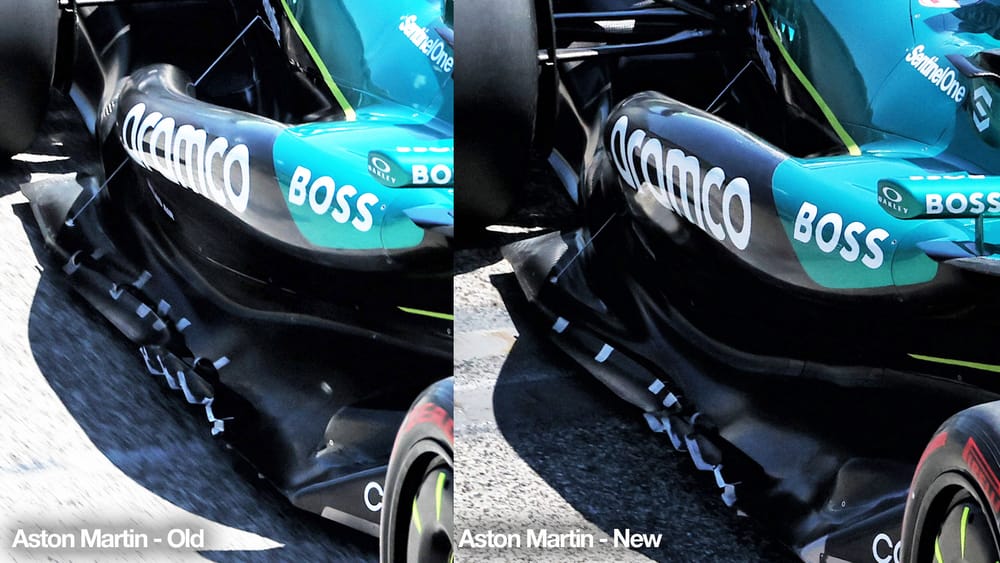Aston Martin was the Formula 1 team that arrived at Imola with the biggest box of upgrades, which ran on Lance Stroll’s car in practice on Friday while Fernando Alonso continued with the old specification. On Saturday, both cars will have the new package.
Imola is an old-school track. When you go off, it’s gravel or grass, which means car balance and driver confidence are critical for a fast lap. Given Stroll’s response when asked his first impressions of the car being that it’s “the same”, that suggests there has not been much of an impact - but that’s not necessarily the whole story.
Imola requires good balance and downforce levels at medium ride heights because most corners here are medium speed. That removes any real problems with the cars generating peaky downforce at very low ride heights, which is probably where these developments are focused. So I’m not sure we would see any real improvement at this track.
As required by the FIA, the Aston Martin upgrades were revealed on the pre-event ‘car presentation submission’ documents, so let’s sort through the changes in the order they were listed.
1 Halo
Aston Martin says: The local detail around the rear halo mounts has been revised with a reduced fin. Changes to the management of the flow around the cockpit alter the load generated in that area as well as affecting the flow behind this region.
Aston Martin has shortened and reprofiled the fin at the rear of the halo, which I have highlighted with a red line. This is to work with a sidepod change that we’ll come to in a moment.
This will allow the flow highlighted with the blue arrows that is coming around the vertical intersection between the top of the chassis and the rear mounting of the halo, to be redirected and then pulled down into the sidepod ski ramp.
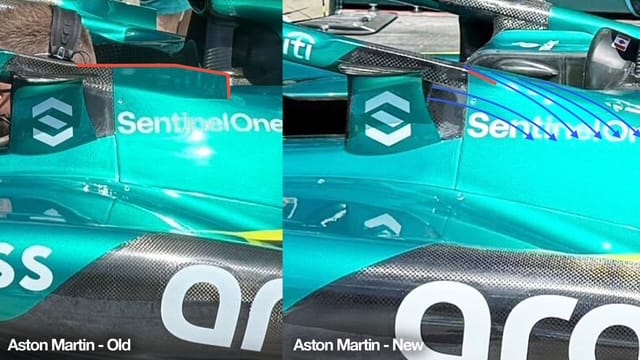
2 Floor (Body, fences and edges)
Aston Martin says: Floor Body: The main body of the floor has evolved slightly with the fences and floor edge. The revised shapes improve the flowfield under the floor increasing the local load generated on the lower surface and hence performance.
Floor Fences: The fences have revised curvature and local details. The revised shapes improve the flowfield under the floor increasing the local load generated on the lower surface and hence performance.
Floor Edge - Performance: Small changes to the details of the floor edge wing and the main floor inboard of this. The revised shapes improve the flowfield under the floor increasing the local load generated on the lower surface and hence performance.
The floor edge highlighted with the red ellipse is the area that is critical to the consistency of downforce from the underfloor as the car changes ride height with speed.
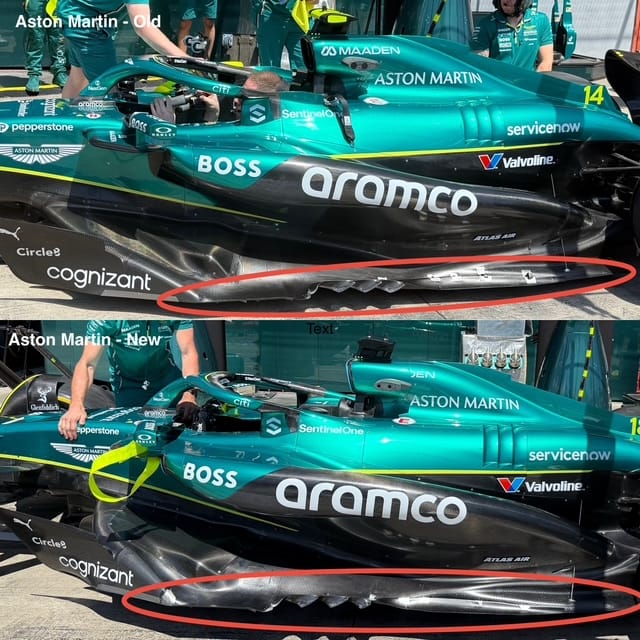
That, together with the position of the centre of pressure (CofP) of the underfloor plays a big part in the overall balance of the car. If that is consistent, it will give the driver more confidence.
It will be at a track with a higher percentage of high speed corners where the car runs lower that these mods could possibly benefit the car. I can’t see the detail well enough to comment as it is more a profile change of the floor side wing, but if it is a product of the new windtunnel (and we know this package has run in there) then circuit data for correlation between tunnel and track is the most important.
3 Diffuser
Aston Martin says: The shoulder of the diffuser has been updated. The revised shapes improve the flowfield under the floor increasing the local load generated on the lower surface and hence performance.
All of the teams now use the maximum diffuser exit area.This is one rule that is easy to read because it has a maximum width, height and distance rear to the rear axle.
To work the underfloor as hard as you can, you need this expansion. However, that comes with a risk of flow separation in the upper corners, which are highlighted in red. I’m a big believer in giving a little away to reduce the risk of airflow separation.
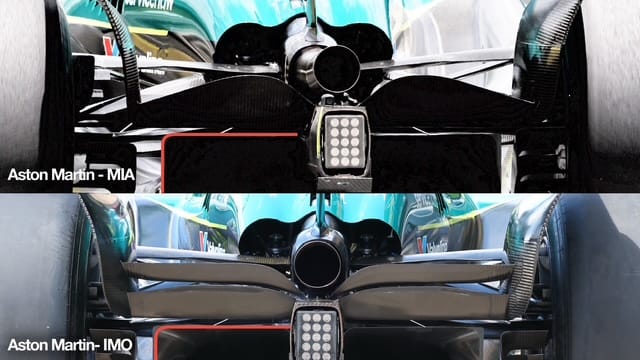
The area that shrouds the gearbox is also critical as it is the rear end of the lowest point of the car. In effect, it is a boat’s bow shape reversed, but on some cars because of the gearbox configuration it’s wider in areas than others.
The cross section volume change needs careful attention. If you expand it too quickly, you will get separation, but if you expand it too slowly you won’t get the performance from it, especially at high ride heights.
4 'Coke bottle' area and engine cover
Aston Martin says: Change to the curvature of the coke. This revised shape is developed alongside the floor edge details to improve the performance of the floor as above.
The outer edge of the sidepods is the most visually obvious change. Aston Martin appears to run the most dramatic internal ‘ski ramp’, which I have highlighted with the red arrows.
This allows the low pressure at the rear of the car to pull airflow down over the top surface of the sidepods, which is highlighted with the red arrows.
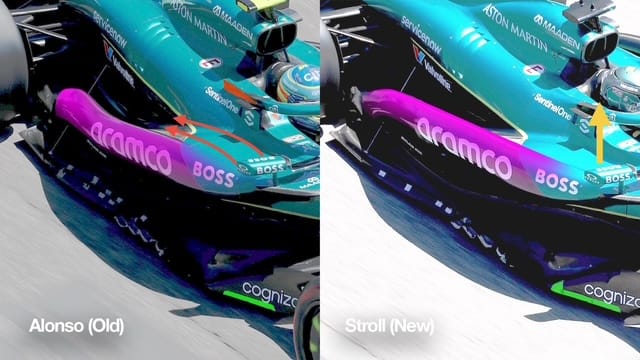
Unfortunately, this can induce lift, which I have highlighted with a yellow arrow on the forward section at the front of the sidepod as the airflow accelerates over that part of the bodywork.
The other potential problem is that it reduces the effect of the ‘Coke bottle’ section where the car body narrows by not using that low pressure area to pull airflow around the side of the car. That, working in conjunction with the front sidepod undercut, improves the performance of the front wing and potentially the sealing of the outer edge of the underfloor.
5 Beam wing
Aston Martin says: The beam wing sections are reduced in incidence compared to the previous version. The reduction in aggression of the beam wing elements reduce downforce but also drag for an overall efficiency improvement at this rear wing level.
The teams will look at the efficiency of all the individual parts of the car and decide which is the best overall package to put on the car for each individual circuit. The beam wing specification is individually the most inefficient component, but it plays a major part in the performance of the diffuser and, in turn, the underfloor.
The previous version is highlighted in red. As you can see, it acts like a flap across the top trailing edge of the diffuser, effectively increasing the diffuser’s extraction potential especially closer to the car centre line.
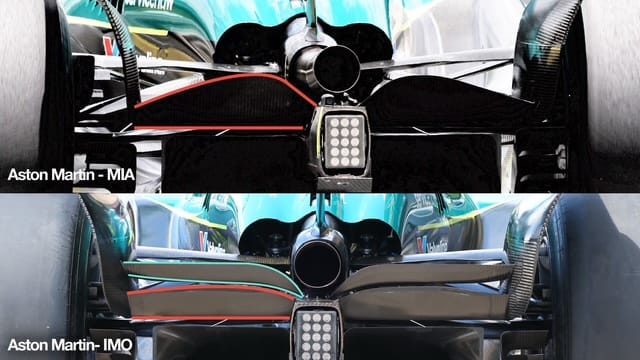
Going to a two-piece beam wing and mainplane (highlighted in red, flap in light blue), will improve the car’s overall efficiency. However, because of that slot gap it will have lost some of that extraction effect on the trailing edge of the diffuser.
It won’t be until we get to a different style of circuit where the cars run lower - probably Barcelona in two weeks’ time - that we see any major performance improvement.
But I’m not going to hold my breath. From what I have seen, I’m pretty sure that Aston Martin will need a bit more before getting into a position to fight for regular points.


